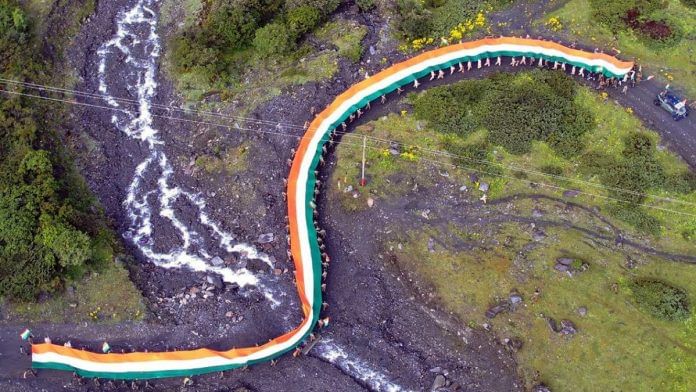The Chief of Defence Staff, General Anil Chauhan, along with the three services chiefs, formally released India’s Joint Doctrine for Amphibious Operations earlier this month. As per the official statement, the declassified doctrine outlines the framework for planning and execution of amphibious operations by integrating maritime, air and land domains.
The doctrine highlights interoperability, rapid response capability and jointness to undertake such operations. Its focus on jointness with unprecedented civil-military fusion is part of India’s ongoing effort to plan for mobilisation at the national level. The timing of the declassification is particularly crucial given the recent challenges India faces from both Pakistan and China at land and sea. While there exist several constraints in the operationalisation of the doctrine, capability development in niche technical areas, institutional adaptation, and strategic signalling will be the most challenging of all.
Balancing flexibility
The command and control structure envisaged in the doctrine looks into the role of undertaking joint operations by all the services, keeping in mind the current organisational structure of the Indian Armed Forces. Dual hatting provisions, that is, a military commander taking on multiple responsibilities and shifting between operations, is also a sign of change that probably stems from India’s past experiences in amphibious operations. To leverage existing interservice coordination, the doctrine advocates for the establishment of Amphibious Force Headquarters while raising specialised capabilities at a steady pace.
Emphasis is also accorded to component commanders during the planning phases. This is followed by clear hierarchical authority during the execution of an operation, thus prioritising an evolved understanding of joint planning. This serves to operational effectiveness when unity at the command level becomes paramount. This approach also acknowledges the domain expertise that each of the services brings while ensuring decisive leadership during critical phases of the operation.
The doctrine also puts emphasis on the idea of Ships Taken Up from Trade (STUFT) and civilian aircraft requisitioning in times of crisis to build amphibious capability within the budget constraints. Understanding characters of modern warfare as inclusive from the global experiences, the doctrine also approaches modern warfare’s total-national character, where military and civilian resources must be seamlessly integrated. The detailed procedures for civil integration suggest intense institutional planning for large-scale operations that would require national mobilisation at the highest level.
Integration of specialised capabilities, such as the Amphibious Beach Units (ABU) and medical support teams, is aimed towards capability development. What is particularly interesting is the idea of an alternative organisation “in the absence of” specialised units that will undertake certain specific tasks in an operation within the current force structure. With respect to the sustenance of abled fighting troops and civilian contingencies, detailed medical support provisions, including surgical teams and hospital ship concepts, are part of comprehensive planning for humanitarian aspects of military operations. This is particularly with respect to the casualty care and evacuation considerations, human costs of amphibious operations and the need for robust medical support infrastructure.
Also read: China wants to create new order in Myanmar. India must switch gears or be dealt out of the game
Operational environment challenges
The emphasis on “over the horizon” operations and Ship-to-Objective Manoeuvre (STOM) capabilities understands modern threat environments rather than operational limitations. The detailed operationalisation of stand-off beaching techniques is to have real-time awareness of contemporary anti-access capabilities of the adversary, while developing credible responses to them. This is in consonance with the changing nature of amphibious operations that will occur in contested environments against technologically sophisticated adversaries. Given the nature of multiple threat vectors, including unmanned systems, cyber warfare, and electronic countermeasures, the doctrine addresses operationalising effective measures to counter them. This positions India ahead of many nations in preparing for multi-domain threat environments.
Network Centric Operations (NCO) and advanced C4ISR systems also find specific mention to aid real-time information sharing and integrated battlespace awareness. The requirement for a communications system “sufficiently hardened” against electronic countermeasures shows realistic planning for operations in contested battlefields. The integration of cyberspace operations considerations places India among the leading nations in recognising cyber as a critical domain for amphibious operations. The directive to address adversary cyber capabilities during planning phases is also an important aspect of modern warfare’s multi-domain character.
The role of intelligence is central to almost all amphibious operations. The Joint Intelligence Preparation of the Operational Environment (JIPOE) will be playing a critical role in an actual operational environment. The emphasis on fusion of multi-source intelligence and deployment in a forward operational environment of intelligence capabilities is of paramount importance. Defense Intelligence Agency (DIA) is tasked with centralising strategic intelligence while maintaining tactical flexibility.
The Joint Doctrine for Amphibious Operations is timely and futuristic. It balances between the operational requirements and the current realities that the Indian Armed Forces face. As an operational guideline, the doctrine will provide a basis to both immediate and long-term capability development agendas, like civil-military fusion and integration of emerging technologies for the Indian Armed Forces. It will drive institutional changes.
However, the doctrine’s extensive dependence on contingency plans and arrangements like from forming headquarters “as deemed fit” to alternative organisations “in the absence of” specialised units, suggests that many critical capabilities are yet to be developed. What is important here is to see how the Indian Armed Forces adapt to the massive structural overhaul without compromising current structures and hierarchies.
Harsh V. Pant is Vice President, Observer Research Foundation, New Delhi. Ankit K. is an Assistant Professor of Security Studies at the Rashtriya Raksha University, Gandhinagar, Gujarat. Views are personal.






